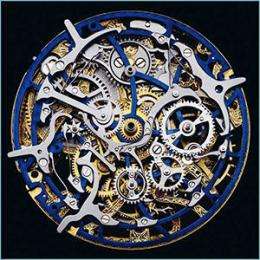New research in mice reveals why the body is so slow to recover from jet-lag and identifies a target for the development of drugs that could help us to adjust faster to changes in time zone.
With funding from the Wellcome Trust and F. Hoffmann La Roche, researchers at the University of Oxford and F. Hoffmann La Roche have identified a mechanism that limits the ability of the body clock to adjust to changes in patterns of light and dark. And the team show that if you block the activity of this gene in mice, they recover faster from disturbances in their daily light/dark cycle that were designed to simulate jet-lag.
Nearly all life on Earth has an internal circadian body clock that keeps us ticking on a 24-hour cycle, synchronising a variety of bodily functions such as sleeping and eating with the cycle of light and dark in a solar day. When we travel to a different time zone our body clock eventually adjusts to the local time. However this can take up to one day for every hour the clock is shifted, resulting in several days of fatigue and discombobulation.
In mammals, the circadian clock is controlled by an area of the brain called the suprachiasmatic nuclei (SCN) which pulls every cell in the body into the same biological rhythm. It receives information from a specialised system in the eyes, separate from the mechanisms we use to 'see', which senses the time of day by detecting environmental light, synchronising the clock to local time. Until now, little was known about the molecular mechanisms of how light affects activity in the SCN to 'tune' the clock and why it takes so long to adjust when the light cycle changes.
To investigate this, the Oxford University team led by Dr Stuart Peirson and Professor Russell Foster, used mice to examine the patterns of gene expression in the SCN following a pulse of light during the hours of darkness. They identified around 100 genes that were switched on in response to light, revealing a sequence of events that act to retune the circadian clock. Amongst these, they identified one molecule, SIK1, that terminates this response, acting as a brake to limit the effects of light on the clock. When they blocked the activity of SIK1, the mice adjusted faster to changes in light cycle.
Dr Peirson explains: "We've identified a system that actively prevents the body clock from re-adjusting. If you think about, it makes sense to have a buffering mechanism in place to provide some stability to the clock. The clock needs to be sure that it is getting a reliable signal, and if the signal occurs at the same time over several days it probably has biological relevance. But it is this same buffering mechanism that slows down our ability to adjust to a new time zone and causes jet lag."
Disruptions in the circadian system have been linked to chronic diseases including cancer, diabetes, and heart disease, as well as weakened immunity to infections and impaired cognition. More recently, researchers are uncovering that circadian disturbances are a common feature of several mental illnesses, including schizophrenia and bipolar disorder.
Russell Foster, Director of the recently established Oxford University Sleep and Circadian Neuroscience Institute supported by the Wellcome Trust, said: "We're still several years away from a cure for jet-lag but understanding the mechanisms that generate and regulate our circadian clock gives us targets to develop drugs to help bring our bodies in tune with the solar cycle. Such drugs could potentially have broader therapeutic value for people with mental health issues."
The findings were published online today in the journal Cell.
More information: A. Jagannath et al. The CRTC1-SIK1 pathway regulates entrainment of the circadian clock. Cell, 29 August, 2013. [epub ahead of print] www.sciencedirect.com/science/ … ii/S0092867413009616
Journal information: Cell
Provided by Wellcome Trust




















